By Natalie Klco ’15
Honors Tutorial College and Physics major studying Music, Ohio University
For two weeks this summer in Arcata, California, I shared a love for an instrument whose mere existence is unknown to most.
I sat next to an older gentleman from the Arcata community at one of our concerts, and he shared with me the fact that he had never heard a marimba performed and had no idea what he should expect from his experience.
Out of the corner of my eye, I had the pleasure of watching his face light up with astonishment and glee as some of the best marimba players in the world dazzled the stage no more than 10 feet in front of us. That man continued to attend our concerts and was one of the few to remain contentedly seated through the entirety of our almost five-hour participants’ marathon concert on the final day of our festival.
About 60 students and faculty gathered in August for the 2013 Zeltsman Marimba Festival. I received funding to attend this event from the Honors Tutorial College and the Ohio University Council on Research, Scholarship & Creative Activity.
Obtaining a good sound from marimba bars depends primarily upon the purity and strength of each vibrational mode that is prominent in the bar. Unlike a tuning fork, the marimba bar will vibrate in many directions (transverse, longitudinal, lateral, and torsional) from each stroke and will produce an entire spectrum of frequencies that define the bar’s timbre.
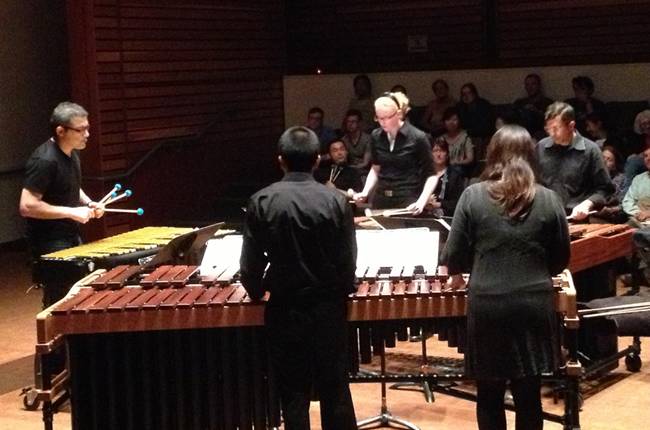
Photo by Denise Fitzgerald
It is necessary for the bars to be tuned by a skilled “master-tuner” since the harmonics naturally found in the bars do not usually produce a ”musical” sound. (A “musical sound” is often defined as having harmonic partials of the fundamental within its spectrum of frequencies).
The tuners that I had the pleasure of meeting and observing have developed techniques that allow them to manipulate many modes of these vibrations. Through experimentation, they have found that certain ranges of the keyboard have dimensions that usually produce vibrations that destructively interfere with more desirable harmonics. In order to improve the resonance and clarity of these bars, these professionals have used their techniques to bring these modes out of dissonance and into harmony with the desirable vibrations of the bar.
In all of this science and experimentation, however, these tuners have not lost sight of the fact that their intent is a pleasurable experience to a human mind, not necessarily perfect numbers on a computer program (though the two may occasionally coincide). Thus, the underside of each and every marimba bar becomes a diary of the exceptional pains taken by the tuner to share with the world his vision of a beautiful sound.
Over the years, scientists have learned about the great achievements that come from experimentation. Whether the experiment yields expected values or not, it is more than likely that we as a society of scientists will have learned something from the experience. Artists at the marimba festival encourage the same regard for experimentation within the students’ practice rooms as they yelled phrases along the lines of “You’re not going to break Bach… experiment!” Their point was that playing a piece repetitively in the same exact way will never allow you to discover anything new within the subtleties of the piece.
What if scientists only ever conducted one experiment with absolutely no variation? They may become extremely accurate and efficient with that experiment, but they would never learn anything new. If you always crescendo in measure 5, you may never know what it would sound like to decrescendo in measure 5. Playing everything exactly metronomically accurate would never allow you to discover that manipulating time can be a powerful and emotional tool. The practice room is thus your personal laboratory where experimentation can and absolutely should take place.
Solo marimba performance does not have an extensive history of expanding knowledge and experienced mentorship as do many other disciplines. For example, physics students today are ”caught up to speed” with the general compilation of knowledge by experienced professors and textbooks with information gathered and tested over thousands of years. These students begin their formal training aware of quantum mechanics and understanding that atoms are divisible, that light exhibits both wave and particle characteristics, and that the luminiferous aether through which light was believed to propagate does not exist. The students are given the benefits of thousands of years of research by thousands of people as their launching pad into the profession.
The beautiful thing about the sciences is that the younger generations will always have more information available to them than their professors had when they were their students’ ages (assuming that the older generation adds to the compilation of knowledge).
The most exciting realization that occurred to me during my time at the Zeltsman Marimba Festival is that the study of the marimba is finally beginning to follow this structure. Instead of being forced to develop their own technique from scratch, students now have technique books available to guide their studies by the experimentation of those who have come before them. I do not believe it to be a stretch to posit that over the past 50 years, more technique books have been written for the marimba than have been written in all of history.
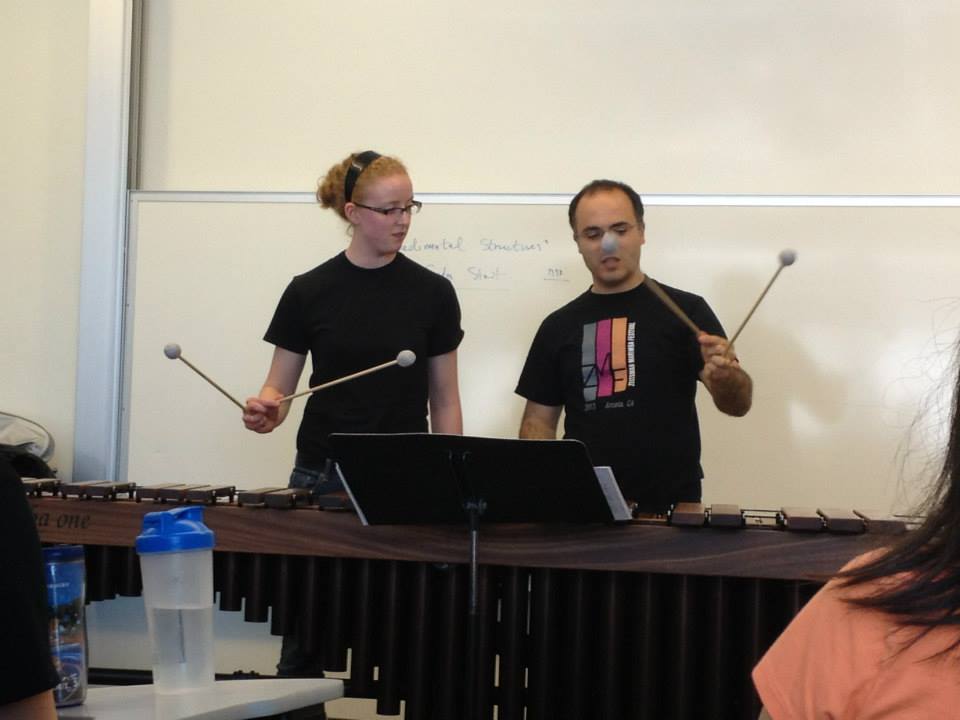
Photo by Noriko Hirao
Imagine having the ability to call up Bach and ask him about a notation issue or have a master class with Mozart. Many of the pioneers of this instrument are still performing and teaching! In addition to pedagogical aspirations, this experienced generation of marimba players has also been dedicated to commissioning composers to write original marimba works, and in doing so has increased the available repertoire by the hundreds.
Now, as students begin their study of this beautiful instrument, they will have a solid foundation upon which they may begin their journey and have the ability and the expectation to contribute to the knowledge of their growing field.
A topic that was covered more than once is the way that we as performers approach written music that is difficult or potentially physically impossible to play. With more and more music being commissioned and written by non-marimba players, many pieces have become technical nightmares and have possibly exceeded a majority of our current abilities. Many marimba players tend to be passionate people with high expectations for themselves and would rather give themselves tendonitis than take out a few notes to make a passage more manageable.
Part of the discussion at the festival brought up the point that tweaking the music by notationally changing the notes on the page deprives the next generation of the challenge of taking all the newly available information and exceeding the previous limits of technical ability. Would removing these ”impossible” sections be akin to a physicist deciding not to pursue the answer to a question that she cannot currently answer? We must not shy away from that which we do not know or cannot perform because the future may hold someone who does know or can perform.
At first glance, the marimba community seems dauntingly large. After a short time, however, you begin to notice that almost everyone shares at least one friend on Facebook, and it is highly likely that you will have seen someone’s teacher at a conference or performance. The artists that shared their wisdom and experiences at the 2013 Zeltsman Marimba Festival have achieved fantastic things yet remain beautifully connected to the eager community of young marimbists who looked on in awe, knowing that there was still plenty of room for a new generation of pioneers.
In the middle of performing an extraordinary piece, they had the ability to explain exactly what techniques and decisions make that moment extraordinary. To them, and consequently to us, playing the marimba is not about mysticism and magic. Instead, the artists showed clarity of mind and oneness with their bodies to bring little resistance between the concepts formulated in their mind, and the abilities of their bodies to outwardly express those concepts to the rest of the world. Whether or not you play the marimba, immersing yourself in the presence of such dedicated people with a complete lack of inner-conflict with themselves and their instruments is a powerful and inspiring experience.


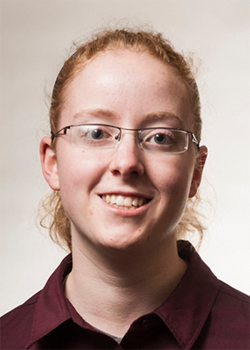
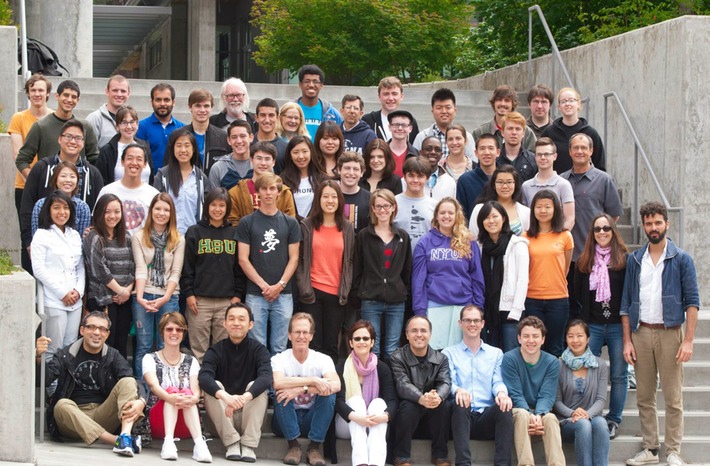


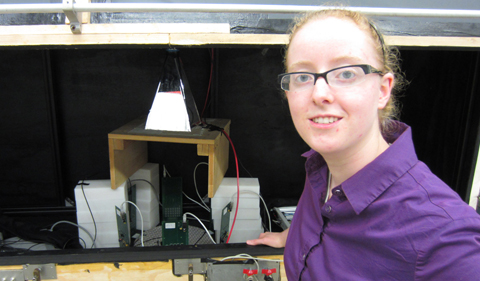














Comments